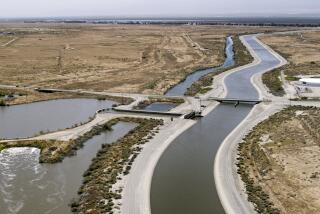Official Now Says High Desert Faces Rationing
In a major reversal, the Antelope Valley’s top water official warned Monday that residents may face water rationing within months if the state’s drought, now in its fifth year, grows worse.
“If the rainfall doesn’t occur, there’s nothing that can be done about it. We’re facing an essentially unprecedented drought in modern history,” said Wallace Spinarski, general manager of the Antelope Valley-East Kern Water Agency, known as AVEK.
The gloomy forecast by the head of the Antelope Valley’s largest water purveyor came after state officials warned Thursday that in March they may have to decide to cut back municipal water allotments from the State Water Project by 70% and eliminate state water for agricultural uses.
The Antelope Valley water agency’s board of directors is expected to call tonight for a hearing on Jan. 29 to discuss how the reduced state water supply would be allocated.
The Antelope Valley gets about half of its water from the California Aqueduct and most of the rest from ground water. Pumping of ground water could be increased, but local officials have been reluctant to increase it by much because it appears to be causing the ground to sink, which could damage buildings.
Until this week, Spinarski had been predicting that the Antelope Valley could weather the drought without water rationing by relying on increased pumping of ground water. But Monday he said that probably would not make up for the latest potential cutbacks.
Before the warning on Thursday, officials of the 30 regional agencies statewide that receive state water, such as AVEK and the Metropolitan Water District of Southern California, had been expecting much milder reductions: 15% for municipal purposes and 65% for agricultural uses.
Spinarski said the potentially deeper cutbacks came as “really pretty much of a surprise to me.” Of his repeated past statements that the Antelope Valley did not face an immediate water shortage, Spinarski said, “It’s embarrassing to me that my optimism was ill-founded.”
State water officials said the more severe water cutbacks are a worst-case prediction that would be put into effect if the state gets as little rainfall in the next two months as it has in December and January.
State water officials said about two-thirds of the state’s population gets at least some of its water through the State Water Project, and thus would be affected by any cutbacks.
More to Read
Sign up for Essential California
The most important California stories and recommendations in your inbox every morning.
You may occasionally receive promotional content from the Los Angeles Times.










